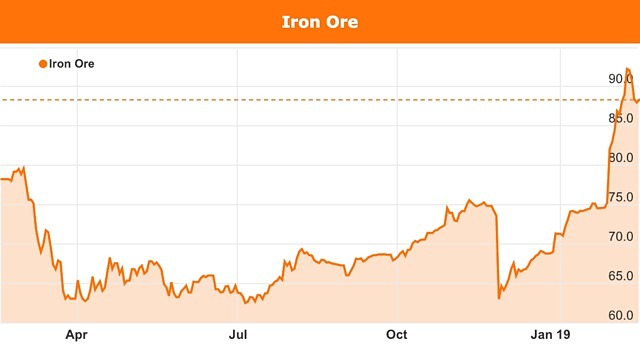Iron ore price plays into Australia’s 2019 federal election

The rising iron ore price is set to bolster government coffers.
The Australian Federal Election, which is due in May this year, is looking like a great election to win.
Whoever gets across the line – and at this stage the polls are still pointing towards Opposition leader Bill Shorten – will inherit a sizeable budget position that may have some upside surprises.
One of those that is playing out at the moment is the booming price of iron ore, which is surprisingly heading quickly towards US$100 a tonne – up almost 50% from just a few months ago.

Iron ore prices have risen sharply in recent months.
While iron ore is unlikely to hold on to some of the spiking spot prices, it looks like it might comfortably outperform budget forecasts and increase the revenue for iron ore producers and the Western Australian and Federal Governments.
Why are iron ore prices up?
There are a couple of main reasons for the somewhat surprising iron ore price boom.
The most recent is the supply shock coming out of Brazil following the tragic tailings dam accident at Vale’s Feijao mine in January.
That accident, which come on top of an earlier dam accident at Vale and BHP’s Samarco operations, has caused a lot of soul searching in Brazil and understandably engineers are now closely checking all of the remaining tailings dams in the country to ensure there is no repeat of these two devastating accidents which caused many fatalities.
The Samarco accident happened in 2015 and that large mine has still not returned to operations so markets are now accounting for a very long-term reduction in Brazil’s output.
Brazil and Australia are the world’s two biggest suppliers of seaborne iron ore and China is the biggest customer so any reduction in the availability of iron ore to feed steel mills is bound to feed into higher iron ore prices.
Some early estimates were that the accidents would take about 40 million tonnes of iron ore out of the market but with the Brazilian Government and Vale now being very conservative and suspending operations at more mines that figure could rise.
What is happening in China?
The other factor in this equation is Chinese demand, which has been predicted to soften after a long strong, in this case by lightening up a little on pollution restriction on when steel can be made.
That has led to much stronger than predicted Chinese demand for lower grade iron ore, even from well before the Feijao disaster interrupted supply.
That has been particularly helpful for Fortescue Metals (ASX: FMG), which supplies lower quality Australian iron ore than BHP (ASX: BHP) and Rio Tinto (ASX: RIO).
Indeed, the rising iron ore prices have boosted the share prices of all three.
Fortescue is up more than 37% since the start of the year, Rio Tinto is up 20% and BHP is up more than 10% so the share market obviously thinks the rising price of iron ore will give them all a significant boost.
Reasons high prices will moderate
Even the most rusted on iron ore bulls still thinks that prices could moderate from here, even if they then stay at relatively elevated levels for some time.
Part of their reasoning is that the Chinese steel mills are suffering intense margin pressure at current prices.
As the mills ramp up production after the Chinese New Year holiday and before stricter seasonal pollution controls, production growth could slow and demand for lower grade iron ore might continue to strengthen to try to avoid negative margins.
Some analysts predict iron ore prices will need to come back towards around US$75/t so that the steel mills can function with a positive margin.
The other thing that could happen if iron ore prices remain elevated is that marginal mines in Australia and elsewhere will move back into production to overcome the supply shortage.
The last mining boom saw the development of a lot of iron ore mines that were moved on to care and maintenance after prices fell and many of these could move back into production quite quickly.
All told, though, the unexpected boom in iron ore prices will have political players on both sides breaking out their calculators and working out when the Federal Budget might move into balance.
The spoils of victory in the Federal election could be even greater than expected, even if iron ore prices moderate a little from here.
